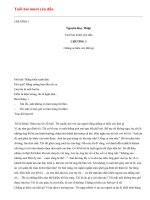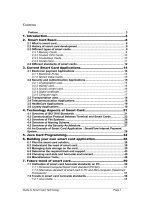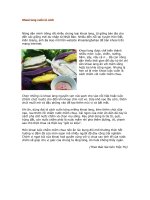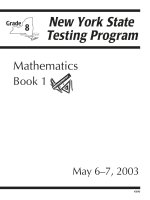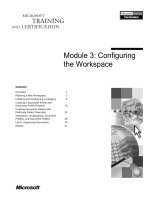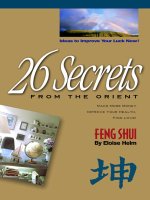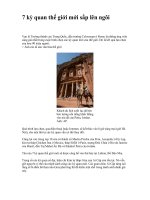Tài liệu SOFT CINEMA navigating the database docx
Bạn đang xem bản rút gọn của tài liệu. Xem và tải ngay bản đầy đủ của tài liệu tại đây (2.74 MB, 21 trang )
SOFT CINEMA
navigating the database
TEXAS
MISSION TO EARTH
ABSENCES
Cinema and Software
Lev Manovich
The Future Was Then
Sheldon Brown
The Maturity of New Media
Jeffrey Shaw
Films
Introductions
Lev Manovich | Andreas Kratky
Booklet-readers-spreads-v7.indd 1Booklet-readers-spreads-v7.indd 1 3/1/05 2:48:29 AM3/1/05 2:48:29 AM
Lev Manovich | Andreas Kratky
Soft Cinema: Navigating the Database
Distributed by The MIT Press, 2005
Massachusetts Institute of Technology
Cambridge, Massachusetts 02142
© The MIT Press, 2005
All rights reserved. No part of this book may be reproduced in any form by any electronic or mechanical means
(including photocopying, recording, or information storage and retrieval) without permission in writing from
the publisher.
MIT Press books may be purchased at special quantity discounts for business or sales promotional use.
For information, please email or write to Special Sales Department, The MIT Press,
5 Cambridge Center, Cambridge, MA 02142.
ISBN 0-262-13456-X
Produced with the assistance of:
BALTIC The Centre for Contemporary Art, Gateshead, UK
CAL-IT (2) (California Institute for Telecommunications and Information Technology),
San Diego and Irvine, USA
CRCA (Center for Research in Computing and the Arts),
University of California - San Diego, USA
RIXC (The Centre for New Media Culture), Riga, Latvia
ZKM (Center for Art and Media), Karlsruhe, Germany
Cinema and Software
The twentieth century cinema ‘machine’ was born at the intersection of the two
key technologies of the industrial era: the engine that drives movement and the
electricity that powers it. While an engine moves fi lm inside the projector at uni-
form speed, the electric bulb makes possible the projection of the fi lm image on
to the screen.
The use of an engine makes the cinema machine similar to an industrial
fac tory organized around an assembly line. A factory produces identical objects
that are coming from the assembly line at regular intervals. Similarly, a fi lm
projector spits out images, all the same size, all moving at the same speed. As
a result, the fl ick er ing irregularity typical of the moving image toys of the nine-
teenth century is replaced by the standardization and uniformity typical of all
industrial pro ducts.
Cinema also refl ects the logic of the industrial era in another way. Ford‘s
assembly line, introduced in 1913, relied on the separation of the production
process into a set of repetitive, sequential, simple activities. Similarly, cinema re-
placed previous modes of visual narration with a sequential narrative and an
assembly line of shots that appear on the screen one at a time.
Given that the logic of the cinema machine was closely linked to the logic of
the industrial age, what kind of cinema can we expect in the information age?
Rather than waiting for this new cinema to appear, the Soft Cinema project
generates new cinema forms using the key technology of the information society–
a digital computer.
As I have already explained, the logic of twentieth century cinema was not
dir ectly connected to the operation of an engine but instead refl ected the
industrial logic of mass production, which the engine made possible. Similarly,
the Soft Cinema project is interested not in the digital computer per se, but rather
in the new structures of production and consumption enabled by computing.
Booklet-readers-spreads-v7.indd 2-3Booklet-readers-spreads-v7.indd 2-3 3/1/05 2:48:30 AM3/1/05 2:48:30 AM
Our research follows four directions:
1. Following the standard convention of the human-computer interface, the dis-
play area is always divided into multiple frames.
2. Using a set of rules defi ned by the authors, the Soft Cinema software controls
both the layout of the screen (number and position of frames) and the se-
quences of media elements that appear in these frames.
3. The media elements (video clips, sound, still images, text, etc.) are selected
from a large database to construct a potentially unlimited number of different
fi lms.
4. In Soft Cinema ‘fi lms’ video is used as only one type of representation among
others: motion graphics, 3D animations, diagrams, etc.
Together these directions defi ne a new aesthetic territory. The three fi lms pre -
sent ed on the Soft Cinema DVD explore some parts of this terrain.
When they are shown as installations, each of the fi lms is assembled by the
Soft Cinema software in real time. As a result a fi lm can run indefi nitely without
ever exactly repeating the same edits. To adapt the fi lms to the DVD medium we
capture specifi c software ‘performances’ directly off the screen. All these alter-
native versions are placed on the DVD, which is programmed to navigate
bet ween them. Consequently there is no single ‘unique’ version of each fi lm. Not
everything will be different with every viewing, but potentially every dimension
of a fi lm can change, including the screen layout, the confi guration and combi-
nation of the visuals, the music, and the narrative.
The following pages introduce these fi lms and the people who worked on
them in more detail.
LEV MANOVICH
The Future Was Then
In the future, cinema will be: void dead (); int eractive (); char wet ();
struct complex {double immersive; double ubi quitous;}; typdef
struct complex subversive implanted organic continuous.
There are many other functions, classes and variable types by which to
declare what it is that will create the foundations of the future of cinema. Soft
Cinema provokes speculation on this, but it does so not by positing a future
cinema but by enacting a present cinema. After I watch the works that constitute
Soft Cinema, the normative cinema of my time feels nostalgic.
New media art is science fi ction. It operates by extrapolating cultural vectors
that are technologically infl ected. There is good sci-fi and bad sci-fi , and bad
sci-fi that can be seen as good with the right attitude. The making of good sci-fi
is grounded in a clarity about the direction of cultural vectors. It is grounded in
possibilities that extend out from the actualities of transformation, not from pure
fantasy. These actualities catalyze the work with the vitality of consequence –
thus the sci-fi of new media art becomes the expression of the particular moment
of a culture and not a speculated future.
I have always thought that Lev only does the simplest things in his work.
What he does is state the obvious. Soft Cinema is obviously the cinema of our
moment. It’s just that no one has done it until now.
SHELDON BROWN
Director of Center for Research in Computing and the Arts (CRCA)
University of California, San Diego
Booklet-readers-spreads-v7.indd 4-5Booklet-readers-spreads-v7.indd 4-5 3/1/05 2:48:31 AM3/1/05 2:48:31 AM
The Maturity of New Media
One of the benefi ts of making art in the early days of new media was that new
media operated outside of the cultural mainstream. As a result, exterior interests
and pressures were few and the exigencies of the work itself were free to drive
the creative process. But this fecund seclusion also had its drawbacks, for there
were few opportunities to exhibit works produced and even fewer occasions on
which anything intelligible was written about them.
For some time new media art practice suffered from this lack of an adequate
critical commentary, while the commentary that did exist typically ranged from
techno-rapture to an even more livid techno-mysticism. Most problematic of all
was an emerging movement of cultural theorists who did not have a language
to express the actual processes of new media art creation. Notwithstanding the
socio-political value of their work, this circumstance allowed these theorists to
superimpose theoretical constructs that transformed and deformed the identity
of the works way beyond their makers’ recognition and intentions.
Lev Manovich’s The MIT Press publication Language of New Media was a
turn ing point in regard to articulating the actual processes of digital creation.
With his book a coherent and revelatory interpretation of new media appeared
and it was written by a practicing artist in the fi eld. In other words, it was written
by an analyst whose theoretical position was founded on, and could be verifi ed
by, the nature of the practice itself.
Lev is cognizant of the technological underpinnings of the new media envi-
ron ment – the properties that inspire, facilitate, constrain and frustrate the artist
in equal measure. In the same way that a good painting demonstrates how a
specifi c handling of brush strokes can constitute a pictorial achievement, so the
successful media artwork demonstrates a precise physical and conceptual trans-
formation of its materials, as opposed to a lesser work that is typically subsumed
by the materials.
The comprehensive understanding that is manifested in Lev’s theoretical texts
has now come to inform his art practice as well. Soft Cinema is the return of
theory out of practice, to the further formation of practice informed by theory. It
is a higher level of practice that is born from a personal process of meditation on
the ‘language of new media’.
I was happy to have had the opportunity to invite Lev, as artist in residence at
the ZKM Institute for Visual Media, to work on the Soft Cinema project together
with Andreas Kratky, and then in 2002 to be able to present it as one of the
bench mark highlights of the Future Cinema exhibition that I curated together
with Peter Weibel. And I am delighted that Soft Cinema has now developed into
this excellent DVD publication, for it will now have the opportunity to edify and
entertain an even larger public and take a prominent place in the history of new
media culture alongside Lev’s inimitable writings.
JEFFREY SHAW
Director, iCinema (Centre for Interactive Cinema Research)
University of New South Wales, Sydney, Australia
details from MISSION TO EARTH
Booklet-readers-spreads-v7.indd 6-7Booklet-readers-spreads-v7.indd 6-7 3/1/05 2:48:32 AM3/1/05 2:48:32 AM
drawings by Lev Manovich, 1981–1991
Lev Manovich
Manovich was born in Moscow where he studied paint-
ing, architecture, computer programming and sem i-
otics. After having practiced fi ne arts for a num ber of
years, he immigrated to New York in 1981. This geo-
graphical move catalyzed a logical shift in his inter-
ests from the still image and physical 3D space to the
moving image, virtual space and the use of digital
computers. He worked professionally in the fi eld of
3D computer animation from 1984 to 1992 while com-
pleting an M.A. in Experimental Psychology and a
Ph.D. in Visual and Cultural Studies.
Since the early 1990s, his work has combined
art practice, theory, lecturing and teaching. As a
visual artist, his projects that investigate the pos-
sibilities of post-computer cinema have been pre-
sented by, among others, ZKM, the Walker Art
Center, KIASMA, Centre Pompidou, and the ICA,
London. His pub li ca tions include The Language of
New Media and Tekstura: Russian Essays on Visual
Culture, as well as many articles that have been
published in over 30 countries. Manovich is a
Professor in the Visual Arts Department at the
University of California, San Diego, where he
teaches courses in new media art and theory.
k
www.manovich.net
Andreas Kratky
Born in Berlin, Kratky studied visual communication,
fi ne arts and philosophy in Berlin and Paris. His art
projects include Postkarten für die Hauptstadt, Berlin;
Berliner –Tonale Portraits, Berlin; and mondophrenetic,
Brussels (collaboration with INCIDENT VZW). Kratky
is responsible for media design and co-di rec tion on
the award winning DVDs That’s Kyogen and Bleeding
Through – Layers of Los Angeles 1920–1986 (both pub-
lished by ZKM), as well as a number of other multi-
media publications. He has also colla borated on re-
search pro jects dealing with informa tion visualization
and inter face design at Karlsruhe and Man chester
Uni ver sities. Since 1998 Kratky has worked at ZKM |
Center for Art and Media, and in 2002 he was ap-
point ed head of ZKM’s Multimedia Studio. Since mid
2004 Kratky has been working as an independent
media artist. He is currently de sign ing and co-
directing several DVD projects with the Uni versity of
Southern California, Los Angeles; Hum boldt Univer-
sität, Berlin; and Université de Paris 1 Panthéon-Sor-
bonne.
details from ABSENCES
Booklet-readers-spreads-v7.indd 8-9Booklet-readers-spreads-v7.indd 8-9 3/1/05 2:48:33 AM3/1/05 2:48:33 AM
TEXAS
How can we represent the subjective experience of a person living in a global
infor mation society? If daily interaction with volumes of data and numerous
messages is part of our new ‘data-subjectivity’, how can we visualize this sub-
jectivity in new ways using new media — without resorting to already normal ized
modernist tech niques of montage, surrealism and the absurd?
Today many places look and feel like composites made up from different
layers: ‘traditional’, ‘global’, ‘capitalist’, ‘post-communist’, etc. How to represent
the typical modern experience of living ‘between layers’ — between the past and
the present, between East and West, between there and here?
Texa s aims to address these questions by using a number of specifi c tech-
niques. The fi lm exists at the intersection of a number of databases, each of
which is structurally organized in the same way and each of which can be
thought of as a portrait of a con temporary ‘global layer.’ ( In other words, each
database is a different set of samples from the same territory.) When the fi lm is
playing, the Soft Cinema software selects samples from these sets and mixes
them in real time.
CREDITS
The original version of Texa s was created for the 2002 Soft Cinema installation
that was commissioned by ZKM Center for Art and Media for the exhibition
Future Cinema: Cinematic Imaginary after Film. This DVD presents the 2004 ver-
sion of the fi lm, which has new narration, music, sound design, and additional
graphics.
[
Lev Manovich | narrative, videography, animations, editing rules ] [Schoenerwis-
sen/OfCD
| Berlin | visualization] [DJ Spooky | Scanner | New York, London | music
from CD The Quick and The Dead ] [George Lewis | New York | music ]
[
Kelly Richardson | New cas tle| media management] [David Ung | San Diego |
narrative graphics] [
Iryna Zinchenko | San Diego | sound editing] [Lee Anne
Schmitt
| Los Angeles | voice over]
Booklet-readers-spreads-v7.indd 10-11Booklet-readers-spreads-v7.indd 10-11 3/1/05 2:48:34 AM3/1/05 2:48:34 AM
TEXAS video database (a partial view)
Database / Sampling
The fi rst database comprises 425 short video clips selected from footage that I
have shot in various locations over a number of years. Extending the genre of a
‘city fi lm’ from the 1920s, the database is constructed to capture the iconography
of a ‘global city’.
The second is a music database created by the composer George Lewis as a
parallel to the video database. It consists of samples taken from his own archive
of sounds – his own version of a ‘global layer’ – as well as from his earlier compo-
sitions. The two data bases are correlated because they use the same parameter –
‘type of space’ – to arrange their samples. (In other words, both video clips and
sound fi les are described using the same spatial categories: ‘city view’, ‘space
with screen’, ‘private interior’, ‘public interior’, ‘object’, ‘working with screen’.)
Along with Lewis’s database, the fi lm soundtrack uses tracks from the CD
The Quick and The Dead by DJ Spooky and Scanner. The CD represents the meet-
ing between different ‘database imaginaries’ of these two outstanding artists. DJ
Spooky brings numerous music traditions, genres, and sound cultures into a
single vast sound space through sampling. His music can be thought of as a
systematic traversal of a multi-dimensional sound database in every possible
direction. Equally versatile and prolifi c in his output, Scanner often generates his
sound databases using a variety of procedures and logics for recording sound in
all kinds of environments. In the words of the artist, “in some ways my work is
concerned with capturing, hunting sound from many inaccessible spaces and
bringing it out, whether it‘s the private phone conversations I fi nd in an airspace
that proved more public than anyone thought, or location recordings from the
restricted access sites which my art projects take me to” (from February 2003
interview, online at www.scannerdot.com). Therefore, if the Texas video database
refl ects visible and spatial characteristics of the ‘global city,’ The Quick and The
Dead captures both its public sound and its less visible communication dimen-
sions: “fl oating above the city: waves, frequency bursts, packets of distilled infor-
mation distributed throughout the spectrum of all communications devices” (DJ
Spooky, from “Web Notes for The Quick and the Dead” at www.djspooky.com).
Booklet-readers-spreads-v7.indd 12-13Booklet-readers-spreads-v7.indd 12-13 3/1/05 2:48:36 AM3/1/05 2:48:36 AM
Proust / Google
If for Proust and Freud modern subjectivity was organized around a narrative – the
search to identify that singular, private and unique childhood experience which
had defi ned the identity of the adult - subjectivity in the information society
may function more like a search engine. In Texa s this search engine endlessly
mines through a data base that contains personal experiences, brand images,
and fragments of publicly shared knowledge. The operation is revealed when
the characters in the story communicate: they semi-randomly jump from one
retrieved ‘record’ to another - similar to the way in which the Soft Cinema soft-
ware retrieves and plays the clips from the video database. While the jumps are
always triggered by something – a question in the conversation, the taste of a
drink or meal – the retrieved records are only loosely connected to the outside
world and to each other.
Database Aesthetics
The editing of the video database in Texa s follows the same poetics of record
retrieval, i.e. weak connections between the displayed records and abrupt shifts
from one record to the next. The clips that the software selects to play one after
another are always connected on some dimension – geographical location, type
of movement in the shot, type of location, and so on – but the dimension can
change randomly from sequence to sequence. In addition, in contrast to a tradi-
tional fi lm, there are no dissolves or cross-fades. Instead one screen layout is
instantly replaced by another. In a nutshell, the ‘hard’ aesthetic of a traditional
narrative is replaced by the ‘soft’ aesthetic of a database narrative.
Finally, the content of Texas addresses the contemporary subjective experi-
ence of living ‘between the layers’ in yet another way. The fi lm belongs to the
series of Soft Cinema editions that I have called GUI (Global User Interface). Each
story in the GUI series occurs in a different location: Texas, Hamburg, Kiev, Mon-
golia. The narratives take place in the present, which has been put through a
light science fi ction fi lter. (However, since in writing them I followed the princi-
ple that they can only take place in locations that I have never visited as an adult,
perhaps they are more accurate than I can imagine.)
Between Narrative and a Search Engine
Each video clip in the Texa s database is described by 10 parameters that specify
where the video was shot, the nature of its subject matter, its average brightness
and contrast, the type of space, the degree and type of camera motion, and so on.
These parameters are used by the software in assembling the movies. Starting
with a particular clip, the software fi nds other clips that are similar to it on some
dimensions. This is similar to the way in which we use web search engines such
as Google. When Google returns a number of results for a particular search term
we can say that all these results are connected on a few dimensions: the search
term, language, domains, etc.
In the case of Texas what you see on screen while the movie is playing are
multiple sequences generated in a similar manner. Each sequence is the result of
a particular search through the Soft Cinema database. Each is perhaps equivalent
to a ‘scene’ in a normal fi lm, while a series of such searches (‘scenes’) becomes
equivalent to a tradi tional fi lm. Film editing is thereby reinterpreted as the search
through the database. Consequently it is possible to describe Texa s as a media
object that exists ‘between narrative and a search engine’.
Editing with Soft Cinema software
Logging clips into the database
Booklet-readers-spreads-v7.indd 14-15Booklet-readers-spreads-v7.indd 14-15 3/1/05 2:48:37 AM3/1/05 2:48:37 AM
Visualization
While the Soft Cinema Project uses a database as the ‘engine’ that generates the
movies, we should also think of the database as a new representational form in
its own right. Accordingly, we asked Schoenerwissen / Offi ce for Computational
Design to translate our video database into a new visual representation. The
resulting dynamic visualization of 425 video clips represents each clip as a small
square, while the human-ascribed sub jective descriptions of the clips appear
to fl oat on the screen. Additionally – since it is the key parameter in Texa s – the
visualization appropriately foregrounds ‘geo location’ by having each of the
squares orbit around a point that represents the city or country in which the
original video clip was shot.
TEXAS video database visualization
by Schoenerwissen
selected clips from TEXAS database
with their keywords (superimposed
over database visualization)
name japan_6_01.mov
cam motion no
distance close
geolocation japan
typelocation pub_interior
description japan fi xed shot
in a restaurant
name LA_029.mov
cam motion no
distance close
geolocation LA
typelocation object
description bubble chair
in trendy hotel
name jap.ber_132.mov
cam motion no
distance far
geolocation berlin
typelocation city_view
description buiding with german
fl ag in the rain
name brazil02_010.mov
cam motion no
distance far
geolocation brazil
typelocation city_view
description city scape
Booklet-readers-spreads-v7.indd 16-17Booklet-readers-spreads-v7.indd 16-17 3/1/05 2:48:38 AM3/1/05 2:48:38 AM
Schoenerwissen / OfCD /video database visu ali zation
Schoenerwissen/Offi ce for Computational Design was founded in 1998 by
Marcus Hauer and Anne Pascual. SW/OfCD develops software and carries out
research in a broad range of areas, including visual network applications, data
mapping systems, and information visualization. In designing dynamic and open
processes that implement temporal and spatial parameters SW/OfCD looks for
new models of representation and aims to make the non-perceived elements
of data processing visible to a general user. Hauer and Pascual studied at the
Academy of Media Arts, Cologne. Their project Minitasking, a visualization of the
Gnutella peer-to-peer network, won both an Award of Distinction in the net excel-
lence category of the Prix Ars Electronica 2002 and the Transmediale Software
Award in 2003.
k www.sw.ofcd.com
George Lewis /music
George Lewis is an improviser-trombonist, composer, and computer/installation
artist. He studied composition with Muhal Richard Abrams at the AACM School
of Music and trombone with Dean Hey. The recipient of a MacArthur Fellowship
in 2002, a Cal Arts /Alpert Award in the Arts in 1999, and numerous fellowships
from the National Endowment for the Arts, Lewis has explored electronic and
computer music, computer-based multimedia installations, text-sound works,
and notated forms. Lewis’ work as composer, improviser, perfor mer and inter-
preter is documented on more than 120 record ings. His oral history is
ar chived in Yale University’s collection Major Figures in Ameri can Music, while
his articles on music, experimental video, visual art, and cultural studies have
appeared in many scholarly journals and edited volumes. The University of
Chicago Press will publish Lewis’ forthcoming book titled Power Stronger Than
Itself: The Association for the Advancement of Creative Musicians.
details from TEXAS
details from TEXAS
Booklet-readers-spreads-v7.indd 18-19Booklet-readers-spreads-v7.indd 18-19 3/1/05 2:48:40 AM3/1/05 2:48:40 AM
Scanner /music
British artist Robin Rimbaud (aka Scanner) creates absorbing, multi-layered
sound scapes that twist technology in unconventional ways. From his early con-
tro versial work using found mobile phone conversations through to his current
focus on trawling the hidden noise of the modern metropolis, his restless ex-
plo ra tions of the experimental terrain have won him international admiration
from, among others, Bjork and Stockhausen. Scanner is committed to working
with cutting edge prac titioners and has collaborated with artists from every
imaginable genre: musicians Bryan Ferry and Laurie Anderson, The Royal Ballet
and Random Dance companies, composers Michael Nyman and Luc Ferrari, and
artists Mike Kelley and Derek Jarman. In addition to producing compositions
and audio CDs, his diverse body of work includes soundtracks for fi lms, perfor-
mances, radio, and site-specifi c intermedia installations. He has performed and
created works in many of the world’s most prestigious spaces including SFMO-
MA, the Hayward Gallery, Centre Pompidou, the Corcoran Gallery of Art, Tate
Modern, and the Royal Opera House, London.
k www.scannerdot.com
DJ Spooky /music
Paul D. Miller is a conceptual artist, writer and musician working in NYC. His
writings have appeared in, among others, The Village Voice, The Source, Art-
forum, Raygun, Rap Pages, and Paper Magazine. He was the fi rst Editor-At-Large
for Artbyte: the Magazine of Digital Culture and he is a co-publisher, along with
the legendary African American downtown poet Steve Canon, of A Gathering of
the Tribes – a periodical dedicated to new works by writers from a multi-cultural
context. Miller’s book Rhythm Science (The MIT Press, 2004) was named one of
the best books of the year by The Guardian and Publishers Weekly.
Miller’s art projects have appeared in a wide variety of contexts, including
the Whitney Biennial; The Venice Architecture Biennale; The Ludwig Museum,
Cologne; Kunsthalle, Vienna; and The Andy Warhol Museum, Pittsburgh. Miller is
most well known under the moniker of his ‘constructed persona’ as ‘DJ Spooky
that Subliminal Kid’. As DJ Spooky he uses digitally created music as a form of
post-modern sculpture and he has recorded a huge volume of music, includ-
ing the score for the Cannes and Sundance award winning fi lm Slam. He has
also collaborated with a wide variety of renowned musicians and composers,
includ ing, among others, Iannis Xenakis, Ryuichi Sakamoto, Butch Morris, Kool
Keith (aka Doctor Octagon), Killa Priest from Wu-Tang Clan, Yoko Ono, and Thur-
ston Moore from Sonic Youth.
k www.djspooky.com
Frame from a clip
used in TEXAS (shot in Riga)
Booklet-readers-spreads-v7.indd 20-21Booklet-readers-spreads-v7.indd 20-21 3/1/05 2:48:42 AM3/1/05 2:48:42 AM
Inga is an alien who comes to Earth from Alpha-1, a planet that is about twenty
years behind Earth culturally and technologically. Mission to Earth is an allegory
of both the Cold War era and of the contemporary immigrant experience that
is so frequently the norm for inhabitants of ‘global cities’. The fi lm reminds
us that, while hybrid identity is often celebrated as progressive, it also entails
psychological trauma.
One of the challenges in creating Soft Cinema fi lms is to come up with narra-
tives that have a structural relationship to the database aesthetics. If Texas uses
semi-ran dom database retrieval to represent ‘info-subjectivity’, then Mission to
Earth adopts the vari able choices and multi-frame layout of the Soft Cinema
system to represent ‘variable identity’. That is, the trauma of immigration, the
sense of living parallel lives, the feeling of being split between different re-
alities. To this end, in generating every part of the fi lm, the software choos-
es from among a number of alternative sequences that refl ect Inga’s variable
identity. Other factors, such as the choice of a large or smaller window to display
a parti cular sequence, and the number of windows (co-present realities) that
appear in a layout, simultaneously tell us what the main character is seeing and
represent her thoughts, memories and feelings.
One of the goals of this fi lm was to visualize the narrative as much through
motion graphics as through live action video. Consequently we invited Ross
Cooper Studios to create a database of short motion graphics clips, which would
respond to the fi lm’s narrative and to the live video footage. In most parts of the
fi lm you will see both video clips and motion graphics clips appearing side by
side. The motion graphics react to the video but they also hold their own. In fact
they form a parallel fi lm that follows the same narrative but visualizes its themes
and the feelings of the characters through different means.
MISSION TO EARTH
CREDITS
Mission to Earth (2003 –2004) was commissioned and produced by BALTIC The
Centre for Contemporary Art (Gateshead, UK).
[
Lev Manovich | narrative, videography, editing ] [Kelly Richardson | Newcastle |
assis tant director & editor] [
CKUK | Christopher Kent | London | narrator]
[
Ilze Black | London | playing Inga ] [ Alec Finlay | Newcastle | playing Alpha-1
commander ] [ Jóhann Jóhanns son | Iceland | music ] [ servo | Los Angeles, New
York, Zurich, Stockholm | archi tectural designs] [
Ross Cooper Studios | Ross
Cooper & Stuart Sinclair | London | motion graphics ] [
Martins Ratniks | Ernest
Karlsons | Ilze Black
| Latvia | videography ] [Christo Wallers | Stuart Harris |
Newcastle | videography] [
Tom Cullen | Newcastle | technical coordination]
Booklet-readers-spreads-v7.indd 22-23Booklet-readers-spreads-v7.indd 22-23 3/1/05 2:48:43 AM3/1/05 2:48:43 AM
Earth
main sources: video shot in London, Berlin,
Rio de Janeiro, Buenos Aires, Sweden (1999 –2003)
1 Tokyo
2 | 3 Los Angeles
4 Newcastle (UK)
12
34
Irbene Radio Telescope /ALPHA-1 Space Center
Irbene Radio Telescope (Latvia) is a 32 meter-wide,
com pu ter con trolled, fully steerable, parabolic dish
that be came opera tional in 1971. While its exact pur-
pose re mains secret, it was most probably used to
spy on sat ellite trans missions between Europe and
North America. Abandoned and nearly destroyed
when the Russian Army de parted Latvia in 1994, the
dish has been successfully repaired by the Ventspils
International Radio Astronomy Center (VIRAC). Since
2001 the Riga-based new media center RIXC has or-
ganized a number of international art work shops and
events that utilize the radio telescope.
1 main telescope dish
2 | 3 top observation area
4 control room
1
234
Booklet-readers-spreads-v7.indd 24-25Booklet-readers-spreads-v7.indd 24-25 3/1/05 2:48:44 AM3/1/05 2:48:44 AM
ALPHA-1
main sources:
1 miniature set (2003)
2 |3 | 7 Novosibirsk (Russia, 1960s)
4 Google image search for “control room” (2004)
5 Pensa (Russia, 1970s)
6 |8 Soviet space program (1960s)
3
45
67 8
1
2
9 the industrial area in UK which inspired
Ridley Scott’s
Blade Runner
(2003 video)
10 Baltic Centre control room (UK, 2003)
11 | 12 drawings by Lev Manovich (1981–1991)
9
10
11 12
Booklet-readers-spreads-v7.indd 26-27Booklet-readers-spreads-v7.indd 26-27 3/1/05 2:48:46 AM3/1/05 2:48:46 AM
Ilze Black / Inga
Born in Riga (Latvia) Ilze Black is an artist, cura tor,
writer, a co-founder of Ambient In forma tion Systems,
and a research fellow at Goldsmiths College, Uni ver-
sity of Lon don. As a founding member of the Latvian-
based art bureau OPEN, since the mid-1990s she has
staged such events as Untitled: subvertizing session
in the streets of Riga, and T-shroom. Most recently her
work has been developed inside the framework of
the Trans-European Re_Public Art network. Projects
include a 24-hour live online road movie titled Broad-
bandit Highway, and the network architecture project
Ambient Wireless.
1
1 Newcastle
2 | 6 Tokyo
3 Irbene Radio Telescope, Latvia
4 Rotterdam
5 studio set
2
3
4
56
Jóhann Jóhannsson /music
Jóhann Jóhannsson is best known as one of the founders of Kitchen Motors,
the Reykjavik based art /music think-tank and record label and as a member of
the Apparat Organ Quartet, which has performed widely in Europe and the US.
He has worked with such internationally known artists as Barry Adamson, Pan
Sonic, Marc Almond, and the Hafl er Trio and composed music for several fi lms
as well as for theatrical and dance productions. In 2002 Jóhannsson’s fi rst solo
album Englabörn – tracks from which are used in Mission to Earth – was released
on the UK based Touch label.
k www.kitchenmotors.com
Kelly Richardson /assistant director & video editor
Currently living and working in England, artist Kelly Richardson was born in
Canada where she studied fi ne art at the Ontario College of Art & Design and the
Nova Scotia College of Art and Design. Her work focuses on the restitution of the
sublime from an ordinary or fl awed moment and her projects have been exhib-
ited at various notable international venues, most recently the Gwangju Biennale,
South Korea; Art Gallery of Nova Scotia, Canada; Cornerhouse, England; and Stills
Gallery / Edinburgh Film Festival, Scotland.
k www.kellyrichardson.net
Booklet-readers-spreads-v7.indd 28-29Booklet-readers-spreads-v7.indd 28-29 3/1/05 2:48:50 AM3/1/05 2:48:50 AM
servo /architectural designs
Established in 1999, servo’s experiments with emergent design, fabrication, and
inter active information technologies focus on the complex interface of emerging
media and architectural practice. Comprising an international network that links
the archi tecture cultures of Europe and the United States, servo has held six solo
exhi bitions, participated in eleven group exhibitions, and its members teach and
lecture widely on both conti nents.
Decentralized across four cities, the collaborative borrows its name from the
servo motor, an apparatus common in the fi eld of cybernetics. Servo motors
translate digital code into machinic processes. They behave principally as
enablers, allowing two dis crete languages to converse and interact. In a similar
way servo organizes, co ordi nates, and ultimately enables new and existing rela-
tions between technologies, forms of disciplinary expertise and modes of pro-
duction, as well as between a variety of cultural infl uences that are specifi c to
the cities from which it operates.
architectural drawings by servo
Ross Cooper Studios / motion graphics
Ross Cooper is a designer and consultant for many companies, including the
BBC‘s Creative Research & Development Department and Ford’s Future Products
Group. As a media artist his works have been exhibited at Ars Electronica, Linz;
Kiasma, Finland; The Digital Hub, Ireland; Gifu Prefecture Takumi Studio, Japan;
Teatro Miela, Italy and El Ciutat, Barcelona. His awards include an Honorary Men-
tion from Prix Ars Electronica, 2 Silver D&AD’s and a Gold from the Art Director’s
Club of Europe.
Designer Stuart Sinclair works in the areas of moving image and interaction
design. His projects include fi lm and television title sequences produced with
Fernando Gutierrez, a partner at Pentagram, London and Princess Produc-
tions, London.
k www.rcstudios.com
motion graphics by Ross Cooper Studios
Booklet-readers-spreads-v7.indd 30-31Booklet-readers-spreads-v7.indd 30-31 3/1/05 2:48:52 AM3/1/05 2:48:52 AM
ABSENCES
My idea for this Soft Cinema edition was to create a fi lm without a pre-formulated
narrative. I started with two assumptions. Firstly that meaning and narrative
cohe r ence can be created through associative chains. Secondly – presuming that
human perception works to connect images that are presented together and to
integrate them into a coherent, meaningful, structure – that it is possible to create
these associative chains through the visual properties of images.
Absences explores two narrative fi elds, which can be described as the fi eld of
urban landscape and the fi eld of natural landscape. Each fi eld is represented by
a number of fi lm fragments and each fragment is described via a number of para-
meters that capture its pictorial properties. I went through a process of re ar rang-
ing, as so ci ating, and adjusting the parameter space until the parameters
adequately captured various visual distinctions between the clips, such as the
dis tinction between concrete and abstract.
As I worked with the database and the parameter space, the idea for a nar ra-
tive came to me. And, as I made editing decisions and developed the two parallel
threads that are intermittently presented throughout the project, so my narrative
idea soli di fi ed into the structure that now guides the viewer through the fi lm. On
the one hand, this structure is an investigation of the pictorial and kinetic dimen-
sions of images. On the other hand, it describes the quest of the narrator-ego
(represented by the camera) for a peaceful and pristine paradise. Throughout an
ever more frantic quest in the labyrinth of a city, the ideas of paradise and real-
ity become increasingly confused and eventually fuse into abstraction.
Soft Cinema software does not generate an aesthetic result per se. The soft-
ware was used as an associative tool that enabled me to explore a collection of
fi lm clips and to arrange them in a coherent way. The machine processed the
material without any aesthetic preconception and this allowed for new narrative
and aesthetic struc tures to arise from an initially indiscriminate database. So,
while it is in the end an algorithm that tells the Soft Cinema display software to
show a certain sequence of video clips, the algorithm itself is the result of an
authoring process. It is, consequently, only through my creative decision-making
– regarding which clips to include in the database, which parameters to select,
how to weight them, and which rhythm in the temporal development to follow –
that the fi nal fi lm takes on aesthetic qualities.
CREDITS
[ Andreas Kratky | Berlin
videography, music, editing, modified version of Soft Cinema software]
Booklet-readers-spreads-v7.indd 32-33Booklet-readers-spreads-v7.indd 32-33 3/1/05 2:48:54 AM3/1/05 2:48:54 AM
building a sequence of clips based on their parameter values
database sorted by contrast
Parameters
For the Absences database each fi lm clip was analyzed in regards to several
visual qualities: brightness, contrast, texture, activity, frequency, the difference
between the center and the periphery, and the difference between the upper and
lower parts of a frame. All of these parameters were described using numerical
values that were acquired with image processing software. In addition I have
also introduced a man ually defi ned parameter that allows for differentiation be-
t ween concrete and abstract clips. By combining these various parameters and
assigning different weights to them, the clips were organized and diverse modes
of associating them were developed.
database sorted by activity
Booklet-readers-spreads-v7.indd 34-35Booklet-readers-spreads-v7.indd 34-35 3/1/05 2:48:56 AM3/1/05 2:48:56 AM
Montage
In addition to investigating the ways in which algorithmic associations between
vis ual elements and narrative can work together, Absences re-examines several
as pects of montage. Although the idea of spatial montage emerged rather early
in fi lm history, it was realized only in a few avant-garde fi lms. Recently, how-
ever, it has become com monly used in the medium of television with many
programs presenting several independent streams of information simultaneous-
ly on the screen.
Absences uses up to fi ve streams of video. In order to facilitate the reading of
these streams, one stream is always made large and thereby prioritized over the
accom panying subordinate streams. (This is the general aesthetic strategy that is
built into Soft Cinema software). The smaller image streams adopt different roles
throughout the fi lm: they are synchronous additional perspectives to the main
stream; they are small glimpses into the future narrative of the fi lm; or they
refl ect what has already passed. The existence of such parallel streams raises the
interesting question of density– how much information can the viewer deal with
given the nature of the footage and the speed of the narrative?
Frames from clips used in
ABSENCES
(shot in Split and Berlin)
Frames from clips used in
ABSENCES
(shot in Newcastle area and Berlin)
Booklet-readers-spreads-v7.indd 36-37Booklet-readers-spreads-v7.indd 36-37 3/1/05 2:49:03 AM3/1/05 2:49:03 AM
Sound
The soundtrack of Absences comes from the same parameter space as is used
to describe the visual clips. The curves describing the temporal development of
the activity and the brightness and contrast values of the individual clips were
used to synthesize sounds, which were then combined with both location sound
and original compositions. The result is a sound track that loosely follows the
images. As several clips appear on screen, so their accompanying sounds become
layered. In this way the rhythm of the fi lmic montage also creates a sonic rhythm.
The overall fi lm sound track follows the progression of the visuals from more
concrete to more abstract by moving from location sound to layered sound.
Spectra of sound layers from ABSENCES
Translation from image parameters into sound
Booklet-readers-spreads-v7.indd 38-39Booklet-readers-spreads-v7.indd 38-39 3/1/05 2:49:05 AM3/1/05 2:49:05 AM
Christine Bokelmann
/graphic design
Berlin-based graphic designer Christine Bokelmann has been responsible for
translating the ideas of Soft Cinema into a print form. To design this booklet, as
well as the 2002 Soft Cinema catalog, she used Soft Cinema software to generate
both the 2D grids and the still images. These elements became ‘building blocks’
out of which the documents were constructed.
Janet Owen /Soft Cinema DVD production manager, catalog editor
Writer, curator and co-founder of the AIM festival, Janet Owen, has organized
exhibitions and related events with, among others, MOCA, LA; Kiasma, Finland;
the Hong Kong Art Center; Tsinghua University, Beijing; and the Susquehanna Art
Museum, US. Her texts have appeared in various exhibition catalogs; magazines,
including RIM and Le Rouge; and the essay anthology Kolibri (Revolver, 2003).
Booklet-readers-spreads-v7.indd 40Booklet-readers-spreads-v7.indd 40 3/1/05 2:49:10 AM3/1/05 2:49:10 AM
